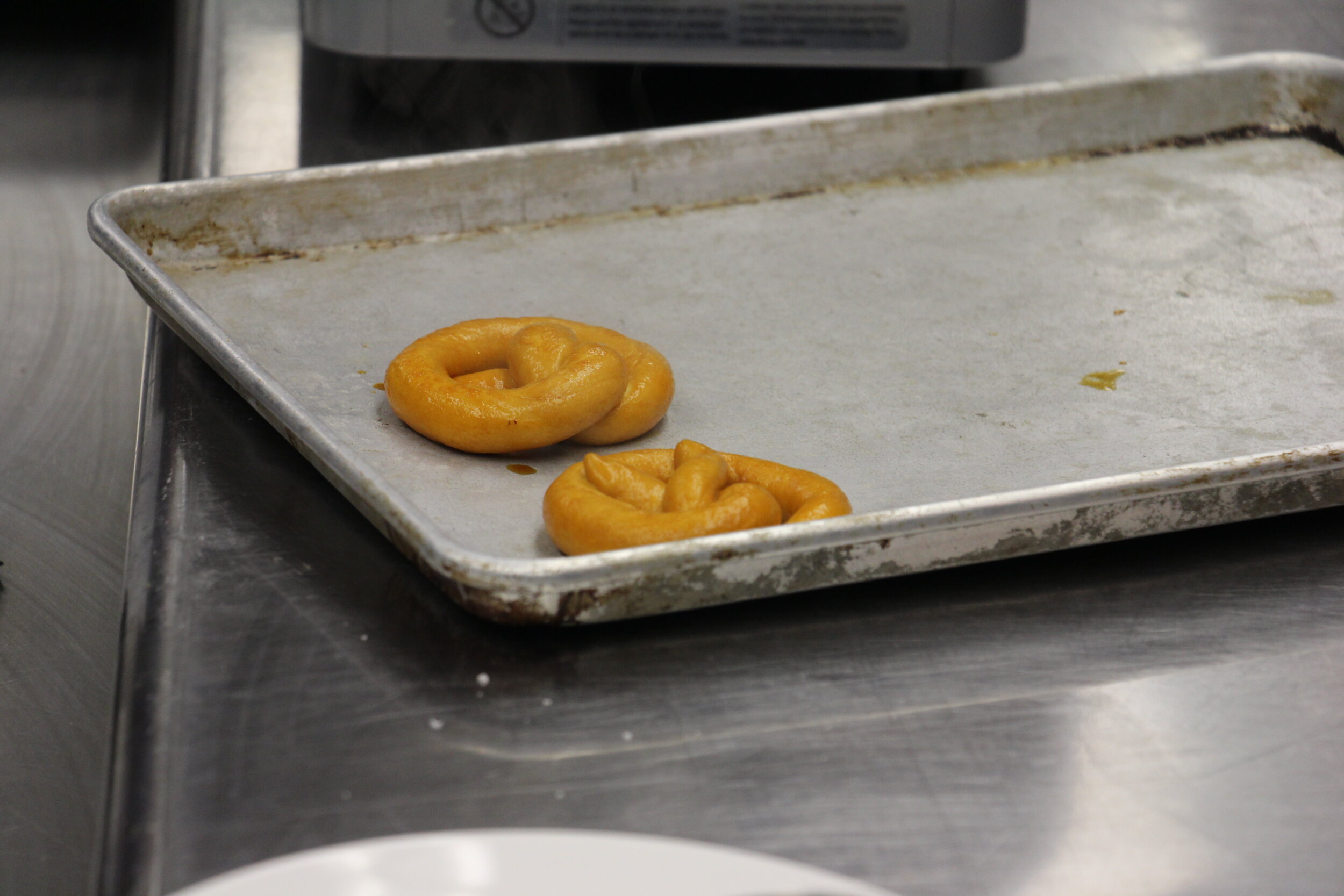Never Too Early to Learn about Food AND Wine: a visit to Newport Vineyards and Café
On perfectly sunny day, students stood by budding grapevines and learned the science of growing grapes for a variety of wines. Our enthusiastic tour guide, Mr. Brenden Deprest, proudly explained how their organic farming led to such healthy growth and delicious reds, whites, and rosés. In the kitchen, the natural teaching and cooking abilities of Chef Andy Teixeira led to the students’ silence as they listened intently while eagerly downing pretzels and sausage.
A trip to the Newport Vineyards can be enjoyable for any person of any age. Whether or not you drink, the venue still offers a rich menu to be devoured while backed by the scenery of the grapevines and aged wine barrels. While the whole wine making process is fascinating–whether it’s learning about the care of the vines or the types of wood that contains the wine–what was a bit more tangibly stimulating was the showcase of the pretzels and the sausage. Before witnessing the magic and craftsmanship that goes into making these dishes, they had to be tasted. The best, most mouth-watering combo: the soft pretzel, made with a secret German recipe, dipped in the brown seed mustard. After every plate of food had been decimated, it was time to see the process behind them. The sausages were made of simple ingredients and put together in a not-so-simple way. The meat was emulsified and dressed with herbs and spices, then had to be packed into sheep intestine. As each little bit was pushed through the meat presser into the lining, it would be twisted and cut to form the shape of a sausage. The pretzels, cooked to a beautiful golden brown, were nearly impossible for us to fold correctly. The table was full of dough blobs. But the taste was never-failing. The Vineyards provide an unforgettable experience for both the eyes and the mouth. —Abby Gibbons ‘19
The Newport Vineyards were built upon a community of support that can be seen through the efforts and partnerships in their business. We learned about how the Vineyards came to be starting with one man making 2,000 bottles of wine to a family making over 25,000 bottles. Before learning how rosé was made, I thought that it was just red and white wine mixed together. At first, the grapes are treated like a red wine and are stemmed and crushed. But then the grapes only ferment and absorb the dark dye for 1-2 days rather than the 1-2 weeks of a red wine. After this process, the grapes are treated like a white wine and are fermented in steel tanks. I also learned that referring to how “dry” a wine is how little sugar is left as the yeast feeds on the sugar.
In the kitchen, the chefs greeted us with pork sausage and pretzels with a mustard sauce and a cheese sauce to dip into. The sausage had lots of herbs and the pretzels were soft. I enjoyed the grainy mustard sauce with both of them. When the chefs showed us how they made the sausage, they mixed in a lot of toasted fennel for the fragrant taste. The chefs told us about how they are completely farm-to-table and make everything from scratch. We learned about their relationship with a local farmer, who supports the restaurant with many vegetables, greens, and beans up until November. –India Roemlein ‘19
The Newport Winery looked similar to any other store until we walked to the backyard where they grow their vineyards. Everything was well organized, and our tour guide told us the function of the fences and how they gather grapes. Then we walked inside and to see the cases that hold different kinds of wine. Different oaks provided different flavors to the wine (French & American oak are mostly used). I was really surprised that the oak barrels are really expensive: one American oak barrel costs 500 – 1000 dollars while one French oak barrel costs 2000 dollars. The process of oxidizing is really complicated and can easily go wrong. Too much oxidation will make the wine really sour. They control the flavor by temperature, too. When there is too much yeast–which feeds on sugar–the wine will get less sweet, and vice versa. –Sylvie Qiu ‘19
I never knew that wine making could be so interesting until we took a trip to Newport Vineyards! So many things surprised me on this trip, like the fact that an empty French oak barrel that holds over 200 bottles of wine costs $2000 or that the tanks of wine are chilled to prevent the yeast in the wine from eating the sugar in order to produce a sweet or semi-sweet wine instead of a dry wine (meaning that the wine isn’t sweet). Another thing that really interested me about the winemaking process was the bottling machine that bottles 133 cases of wine an hour and that together the bottling machine and the labeling machine cost half a million dollars. What surprised me the most, however, was that screw caps are actually better for sealing wine than corks and are more sustainable, especially since most wine bottles you see are sealed with corks. Then we got to see into the restaurant side of things and try some delicious sausages and pretzels with mustard and cheese dipping sauces. The restaurant makes everything from scratch, and all the ingredients they use are pretty local and are always in season. I also learned that sausages can be made with sheep, pig and cow casings, where the size of the sausage depends on the size of the animal–the sausages with sheep’s casing being the smallest and the sausages made with the cow casing being the biggest. I learned so much on this visit and I was really able to see how wine and food work in harmony. –Sarah Costa ‘19













































































